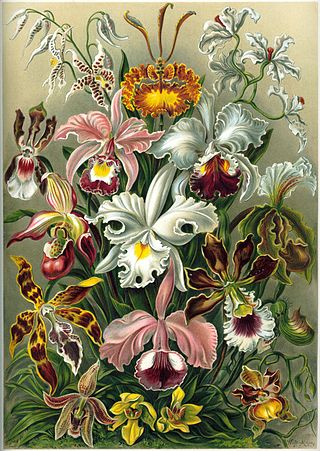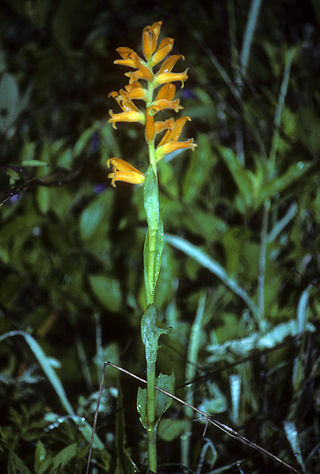
Orchids are plants that belong to the family Orchidaceae, a diverse and widespread group of flowering plants with blooms that are often colourful and fragrant. Orchids are cosmopolitan plants that are found in almost every habitat on Earth except glaciers. The world's richest diversity of orchid genera and species is found in the tropics.

In the botanical classification of plants, Aeridinae Pfitzer is a subtribe of the tribe Vandeae whose representatives all have a monopodial growth habit and do not possess pseudobulbs.

The taxonomy of the Orchidaceae (orchid family) has evolved slowly during the last 250 years, starting with Carl Linnaeus who in 1753 recognized eight genera. De Jussieu recognized the Orchidaceae as a separate family in his Genera Plantarum in 1789. Olof Swartz recognized 25 genera in 1800. Louis Claude Richard provided us in 1817 with the descriptive terminology of the orchids. (See External links below). The next step was taken in 1830-1840 by John Lindley, who recognized four subfamilies. He is generally recognized as the father of orchid taxonomy. The next important step was taken by George Bentham with a new classification, recognizing subtribes for the first time. This classification was first presented in a paper that Bentham read to the Royal Society in 1881. Then it was published in 1883 in the final volume of Genera Plantarum. The next great contributors were Pfitzer (1887), Schlechter (1926), Mansfeld (1937), Dressler and Dodson (1960), Garay (1960, 1972), Vermeulen (1966), again Dressler (1981). and Burns-Balogh and Funk (1986). Dressler's 1993 book had considerable influence on later work.

The Vandeae is a large monophyletic tribe within the family of orchids.

Caucaea is a genus of flowering plants from the orchid family, Orchidaceae. It contains 9 currently recognized species, all native to northwestern South America.

Centroglossa is a genus of flowering plants from the orchid family, Orchidaceae. It contains 5 accepted species, all endemic to Brazil:
- Centroglossa castellensisBrade - Espírito Santo
- Centroglossa greeniana(Rchb.f.) Cogn. in C.F.P.von Martius - Rio de Janeiro, São Paulo
- Centroglossa macrocerasBarb.Rodr.
- Centroglossa nunes-limaePorto & Brade - Minas Gerais, Espírito Santo
- Centroglossa tripollinica(Barb.Rodr.) Barb.Rodr.

Cyrtosia is a genus of flowering plants from the orchid family, Orchidaceae. It contains 5 known species, native to China, Japan, Korea, the Indian Subcontinent, Southeast Asia and New Guinea.
- Cyrtosia integra(Rolfe ex Downie) Garay - Laos, Thailand, Vietnam
- Cyrtosia javanicaBlume - most of genus range
- Cyrtosia nana(Rolfe ex Downie) Garay - Manipur, Thailand, Vietnam, Guizhou, Guangxi
- Cyrtosia plurialataSeidenf. - Thailand
- Cyrtosia septentrionalis(Rchb.f.) Garay - Japan, Korea, Ryukyu Islands, Anhui, Henan, Hunan, Zhejiang

Dichromanthus is a genus of flowering plants from the orchid family, Orchidaceae. As currently delimited, it is monophyletic and includes four species:
- Dichromanthus aurantiacus(Lex.) Salazar & Soto Arenas - much of Mexico, south to Honduras
- Dichromanthus cinnabarinus(Lex.) Garay - from Texas to Guatemala
- Dichromanthus michuacanus(Lex.) Salazar & Soto Arenas - from Texas and Arizona south to Honduras
- Dichromanthus yucundaaSalazar & García-Mend. - Oaxaca

Trizeuxis is a monotypic genus of flowering plants from the orchid family, Orchidaceae. The sole species is Trizeuxis falcata, native to the American Tropics.
Ixyophora is a genus of flowering plants from the orchid family, Orchidaceae. It has 5 known species, all native to South America.
- Ixyophora aurantiaca(Senghas & G.Gerlach) Dressler - Peru
- Ixyophora carinata(P.Ortiz) Dressler - Colombia
- Ixyophora fosterae(Dodson) P.A.Harding - Bolivia
- Ixyophora luerorum(R.Vásquez & Dodson) P.A.Harding - Bolivia
- Ixyophora viridisepala(Senghas) Dressler - Ecuador

Nabaluia is a genus of flowering plants from the orchid family, Orchidaceae. It contains 3 known species, all endemic to Borneo.

Pelexia is a genus of flowering plants from the orchid family, Orchidaceae. It has about 60-70 accepted species, native to Latin America, the West Indies and Florida.
Platyrhiza is a monotypic genus of flowering plants from the orchid family, Orchidaceae. The sole species is Platyrhiza quadricolor, endemic to Brazil.
Polyotidium is a monotypic genus of flowering plants from the orchid family, Orchidaceae. The sole species is Polyotidium huebneri, native to Colombia, Venezuela and Brazil.

Promenaea is a genus of flowering plants from the orchid family, Orchidaceae. It contains 18 currently accepted species, all endemic to Brazil.

Rossioglossum is a genus of flowering plants from the orchid family, Orchidaceae. It has 9 currently recognized species, all native to Mexico, Central America, and northern and western South America.

Sacoila is a genus of flowering plants from the orchid family, Orchidaceae, native to the Western Hemisphere. It occurs in Mexico, Central America, South America, the West Indies and Florida.

Sanderella is a genus of flowering plants from the orchid family, Orchidaceae, native to South America. Two species are recognized at present :

Solenidium is a genus of flowering plants from the orchid family, Orchidaceae. It has three known species, all native to South America.

Zygopetalinae is an orchid subtribe in the tribe Cymbidieae with 418 species.



















